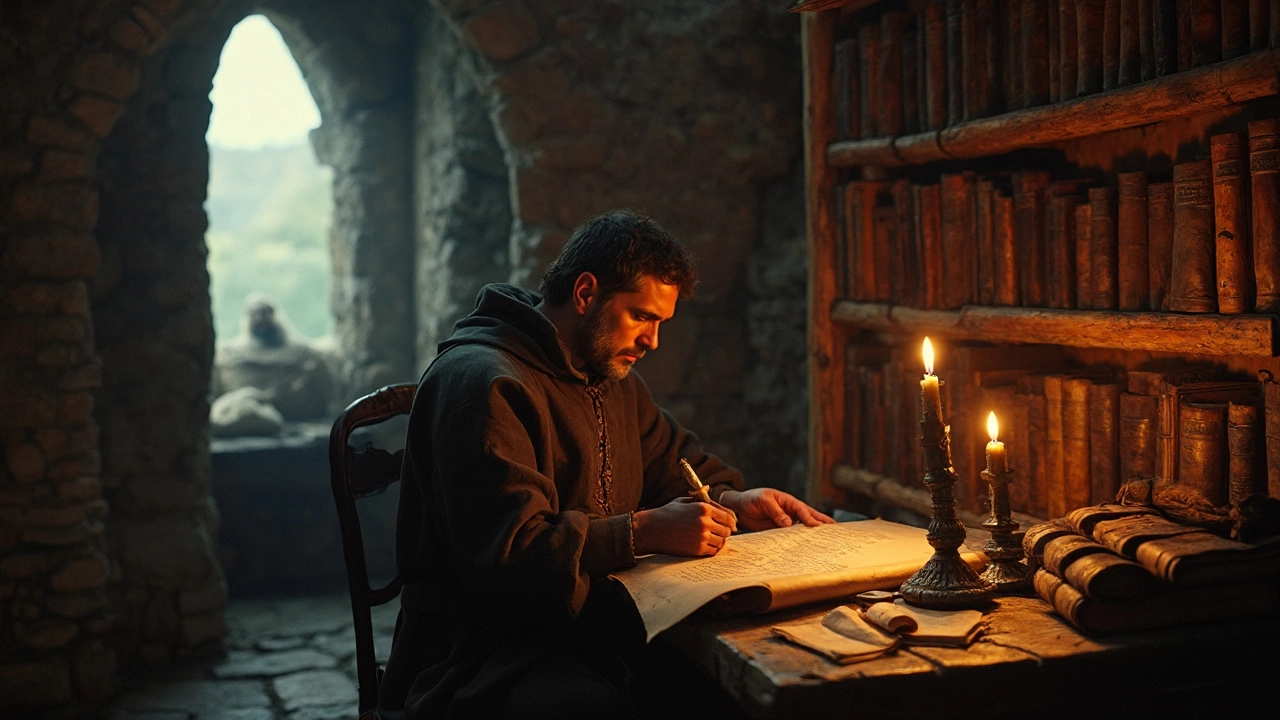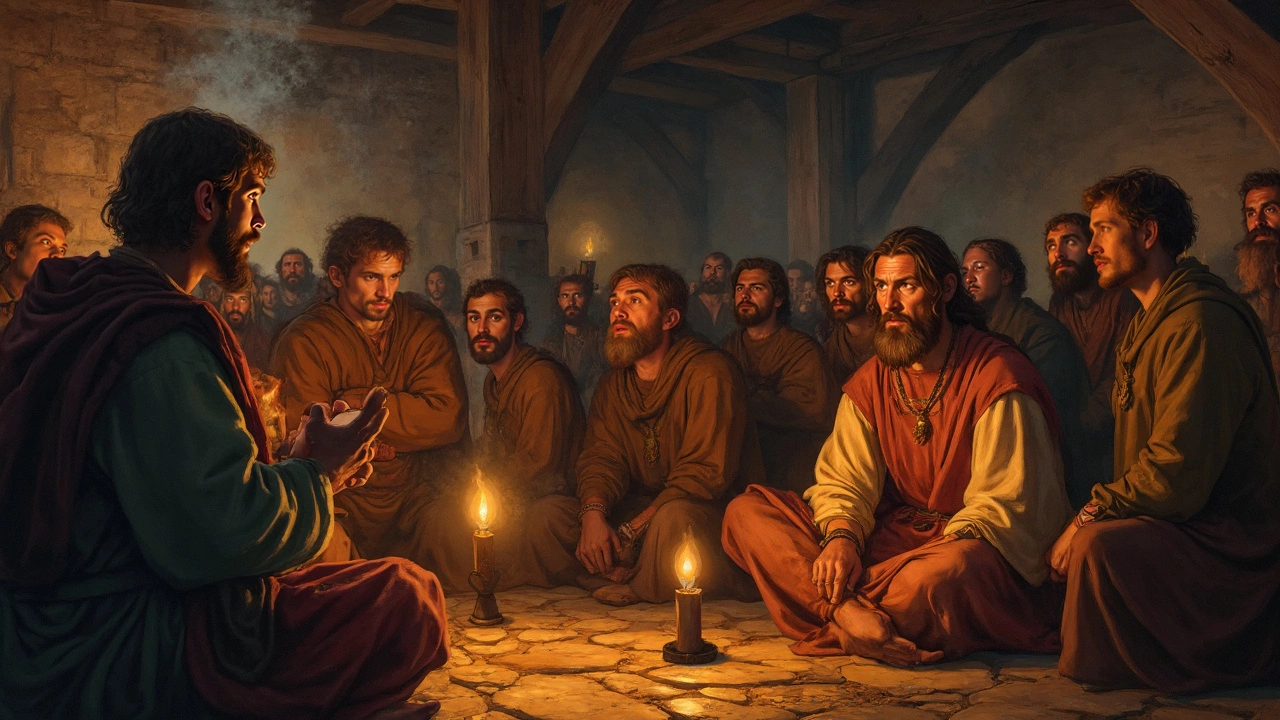Oldest Surviving Poem in Old English: History, Facts & Legacy
 Jul, 1 2025
Jul, 1 2025
You might think English poetry starts with Shakespeare or Chaucer, but it goes much further back. Way back. Imagine a time before grammar rules, before printing presses, even before most folks could write their names. The oldest surviving poem in Old English isn’t just a classroom tidbit for language nerds—it’s a window into a rough, wild world where verse was woven by firelight, passed from mouth to ear, scratched onto animal skin. What’s honestly surprising is how much we can still feel its human spark.
The Origins: Cædmon’s Hymn and the Dawn of Old English Verse
Out of the fog of early English history, one name peeks through—Cædmon. He wasn’t some royal poet or warrior. He was a cowherd, working in a monastery’s stables in seventh-century Northumbria (modern-day Northern England). According to Bede, England’s most famous early historian, Cædmon couldn’t sing or recite poetry like his peers. One night, he had a vision or dream. In that dream, a voice urged him to sing about ‘the creation of all things.’ When he woke up, he could compose a poem on the spot—a miracle in those days. That strange, humble beginning gave the world Cædmon’s Hymn, considered the oldest Old English poem in existence.
So, what’s the big deal about a short poem praising God’s creation? First, it shows that English, as a literary language, springs out of a blend of oral tradition, faith, and everyday life. Second, it’s the oldest surviving example we have in its original Old English—a language that looks more like cryptic code than modern speech. Think about it: without Cædmon’s Hymn, we’d have a century-long blind spot where English would be more rumor than reality. And third, it survived by luck. The only reason we know it at all is thanks to Bede’s ‘Ecclesiastical History of the English People,’ where he included the Hymn in Latin and Old English. That tells you how respected and rare this verse was, even back then.
There might have been earlier poems, but none have survived the centuries. Old English poetry was an oral thing—passed down, altered, lost, or destroyed. Monasteries were the keepers of knowledge, but Viking raids, fires, dissolution, and time erased so much. Just the fact we have something as old as Cædmon’s Hymn feels like a small miracle.
Inside the Hymn: Language, Meaning, and Style
If you expected rhymes and couplets, you’ll be disappointed. Old English verse followed different rules. Cædmon’s Hymn uses alliteration—a repetition of sounds at the start of words—to weave a rhythm. Here’s a chunk in the original:
Nu sculon herigean heofonrices Weard, Meotodes meahte and his modgeþanc, weorc Wuldorfæder, swa he wundra gehwæs, ...
Pretty tough, right? In English translation, it says: "Now we must praise the Guardian of Heaven, the power and wisdom of the Creator, the work of the glorious Father..." The language feels simple, but it’s dense with meaning and meter. Poets then weren’t worried about wide vocabularies or fancy metaphors—they valued memory tricks and sound. That’s why alliteration ruled, and why the poem is easy to chant.
One cool thing is how Cædmon’s Hymn uses compound words. Old English loved to mash two ideas together—like ‘heofonrices Weard’ (Guardian of Heaven) or ‘Wuldorfæder’ (glorious Father). These kennings, as they’re called, later inspired Tolkien, who lifted the trick for his "Lord of the Rings" languages.
Probably the most striking part, though, is how this first English poem is deeply religious. It’s not about battles or love, but creation itself. Christianity was new in England then, and monks wanted poetry to serve faith, to teach. Cædmon’s Hymn fit that mission perfectly—simple, memorable, and full of wonder.

Why Did This Poem Survive When Others Didn’t?
Here’s a wild fact—more than 90% of all Old English literature is lost. Why did Cædmon’s Hymn beat the odds? First, it was lucky enough to get written down in multiple manuscripts. Scribes kept copying it long after Cædmon died. So if one monastery burned or was raided, another copy might have survived elsewhere. The poem has been found in at least 21 different manuscripts, sometimes lurking as a side note in Bede’s history. That’s an insane survival record for a poem from this far back.
Also, Bede’s stamp of approval mattered. He wasn’t just a monk; he was the superstar historian of his era. When Bede put a story in his book, medieval readers kept it alive. Because the poem fit the teaching goals of churches and monasteries, it got repeated and preserved. If Cædmon had written about cowherding, we might never have seen his words.
Another odd survival twist: most Old English poetry was about heroics—like Beowulf—or epic, tragic sagas. That stuff, too, often survived in just one manuscript (looking at you, Beowulf). Cædmon’s Hymn, though, felt safe and pious. It fit what monks liked to keep. Other everyday songs, jokes, or tales turned to dust, while this little hymn kept going.
Scribes sometimes altered the wording as Old English dialects shifted. Some manuscript versions add, skip, or switch words around. That’s normal for an oral poem caught on paper. But the backbone of the hymn—the praise and rhythm—stayed the same.
The Impact on English Literature and Language
It’s amazing to think how a guy who probably never went to school shaped English poetry. Cædmon’s Hymn set the tone for later Old English verse: alliterative, religious, stuffed with metaphor. Everything from Beowulf to The Wanderer owes a bit to this scruffy cowherd’s dream.
Here’s another cool bit: Old English poetry didn’t use rhyme the way later English verse does. Instead, poets leaned hard on alliteration and stress. This form, sometimes called alliterative verse, ruled England for centuries. Even after Norman French swept in after 1066, changing the face of English, echoes of Cædmon lived on.
Cædmon’s Hymn also plays a starring role in linguistics. It’s a key reference point for how Old English sounded, how it formed grammar, and how words transformed over time. You can track changes in spelling, pronunciation, and dialect sweatily through its versions. Reading the hymn is like fossil-hunting for the very roots of our language.
Writers from centuries later, like Tolkien, were obsessed with the texture of Old English poetry. Tolkien taught Old English at Oxford and mined the hymn, among other works, for inspiration in his own writing—the grand, rolling sound of names and places in "The Lord of the Rings" has its flavor from the hymns and sagas of Old English.
Even today, lovers of language, history buffs, and sometimes even regular folks are drawn to these earliest lines. Every now and then, you’ll see modern translations or adaptations, and teachers use it to show how far English has come (and how much it’s changed).

How to Read, Translate, and Appreciate Old English Poetry
You don’t need to be a medievalist to feel the raw beauty of Old English. Sure, the language looks like gobbledygook at first, but there are ways in:
- Find a good facing-page translation. That means Old English on one side, modern English right beside it. This setup shows you both the sound and the meaning.
- Say it out loud, or listen to a recording by a scholar. The alliteration and stress patterns pop when chanted, not just read.
- Don’t worry about every word. Old English bristles with strange terms, but focus on the music of the poem—its rhythm, its flow, its strong memorable sounds.
- Look for kennings and vivid imagery, those odd doubled words that crack open fresh meanings.
- If you really get hooked, there are apps, websites, and even YouTube channels that break down Old English poetry, letter by letter.
One tip that helps: don't obsess about translating every single word. Think about the feeling the poem stirs—a sense of awe, a deep quiet, the hush of creation. That’s what mattered to Cædmon and his first listeners.
Why spend time on this old cowherd’s hymn in 2025? It’s the beginning of the story we’re still living, every day we speak, text, or write English. When you hear an ancient Anglo-Saxon word echo up through the centuries, it’s like a secret handshake between you and a cattle-herder from a windswept corner of long-lost England—a reminder that poetry, even in its simplest form, can outlast almost anything.